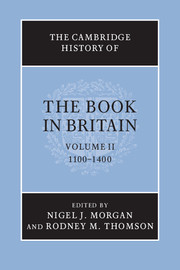Book contents
- Frontmatter
- Preface
- The roles of books
- Book production
- Readership, libraries, texts and contexts
- 9 Library catalogues and indexes
- 10 University and monastic texts
- I Biblical exegesis, theology, and philosophy
- II Latin learning and Latin literature
- III Encyclopaedias
- 11 Law
- 12 Books for the liturgy and private prayer
- 13 Compilations for preaching and Lollard literature
- 14 Spiritual writings and religious instruction
- 15 Vernacular literature and its readership
- 16 History and history books
- 17 Archive books
- 18 Scientific and medical writings
- 19 Music
- 20 Illustration and ornament
- List of abbreviations
- Bibliography
- Photo credits
- General index
- Index of manuscripts
- Plates 1
- Plates 2
- References
II - Latin learning and Latin literature
from 10 - University and monastic texts
Published online by Cambridge University Press: 28 November 2008
- Frontmatter
- Preface
- The roles of books
- Book production
- Readership, libraries, texts and contexts
- 9 Library catalogues and indexes
- 10 University and monastic texts
- I Biblical exegesis, theology, and philosophy
- II Latin learning and Latin literature
- III Encyclopaedias
- 11 Law
- 12 Books for the liturgy and private prayer
- 13 Compilations for preaching and Lollard literature
- 14 Spiritual writings and religious instruction
- 15 Vernacular literature and its readership
- 16 History and history books
- 17 Archive books
- 18 Scientific and medical writings
- 19 Music
- 20 Illustration and ornament
- List of abbreviations
- Bibliography
- Photo credits
- General index
- Index of manuscripts
- Plates 1
- Plates 2
- References
Summary
The specific texts of Latin literature which were written by hand on parchment or paper and were often eventually bound in books, the types of manuscripts in which they were assembled, the varieties of layout that were adopted for presenting them, the scripts preferred for recording them, the scope and content of the material that introduced, accompanied or followed them – all of these variables modulated over the three hundred years under examination here, as did the social status and institutional affiliation of the authors who produced the contents and of the book makers who manufactured the forms, the sorts of institutions and individuals who commissioned and owned them, the kinds of readers who received them and transmitted them, and the settings in which they were read, studied and explicated.
Although in our times the abilities of reading and writing are regarded as being closely related or even indifferentiable, the handwritten quality that the word manuscript proclaims should not make us underestimate how distinct the skills of composing book-length texts (authors), writing them into book form (scribes) and reading them could be (readers). When the texts in question are Latin, the reason for this distinctness lies partly in the specific oddity of the stature that the language held in the Middle Ages, partly in the fundamental differences between manuscripts and printed books. The special place of Latinitas affected what was written and how, as well as who read it and how.
- Type
- Chapter
- Information
- The Cambridge History of the Book in Britain , pp. 229 - 244Publisher: Cambridge University PressPrint publication year: 2008
References
- 1
- Cited by



